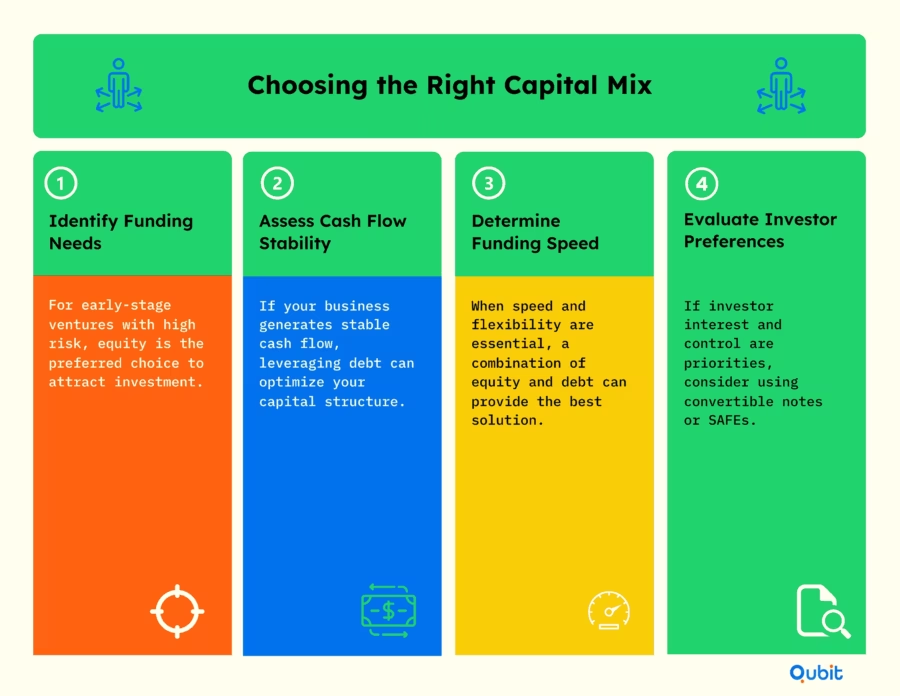Determining the right mix of financing is one of the most critical decisions businesses face. Balancing equity and debt can significantly impact growth, control, and financial stability. While equity involves raising funds by selling ownership stakes, debt requires borrowing with a commitment to repayment. This fundamental choice shapes the trajectory of operations and long-term strategies.
Choosing between these options often depends on variables like ownership retention, repayment obligations, and scalability.
In this article, we aim to provide actionable insights on how businesses can achieve their optimal financing mix. Let’s jump right in!
Optimizing Equity Financing: Weighing the Pros and Cons
Equity financing offers entrepreneurs a compelling option for raising capital, particularly in the dynamic early stages of a business. Whether through venture capital investments, angel investors, or public offerings, understanding what is the difference between equity and debt financing can help founders make informed decisions tailored to their growth strategies. This section explores the benefits and drawbacks of equity financing, using real-world examples to illustrate its transformative potential.
Advantages of Equity Financing
Equity financing provides unique advantages that appeal to startups and businesses with innovation-driven goals.
- No Mandatory Interest Payments: Unlike debt financing, equity financing does not require businesses to repay loans or interest. This means that startups can allocate their limited cash flow toward operational priorities like product development and marketing without the financial strain of recurring payments. Facebook’s IPO serves as a prime example—by raising equity capital, the company avoided debt while scaling its global reach.
- Encourages Innovation and Growth: Investors, particularly venture capitalists, often prioritize reinvesting profits into groundbreaking ideas over immediate returns. This focus fosters innovation and positions businesses for long-term success. For instance, venture capital funding trends, such as Accelerated Innovation, demonstrate how equity financing can scale research-intensive startups at unprecedented speeds.
Drawbacks of Equity Financing
While equity capital can drive growth, it comes with challenges that founders must carefully weigh.
- Dilution of Ownership: Selling shares to investors reduces the founder’s ownership percentage, which can complicate decision-making processes. As more stakeholders gain influence, aligning on business strategies can require additional negotiation and time.
- Loss of Control: Equity investors often seek representation on the board or input into major decisions. While their expertise may be valuable, founders may feel constrained by external expectations, especially if their vision diverges from that of their shareholders.
Flexible Alternatives
For startups hesitant to dilute ownership early, convertible debt vs safe notes offer flexible financing solutions. These instruments provide businesses with immediate funding while deferring equity conversion until later stages, allowing founders to evolve their strategies without compromising control prematurely.
Equity financing is a powerful tool, but its suitability depends on a business’s priorities, growth strategy, and willingness to share control. Founders must strike the right balance between accessing resources and retaining influence over their company’s future.
Harnessing Debt Financing: Benefits and Caveats
Debt financing is a powerful tool for businesses seeking to fund growth or maintain operations while preserving control. Unlike equity financing, which requires giving up partial ownership, debt financing allows businesses to retain full ownership and voting rights. This distinction makes it particularly appealing for founders and companies aiming to protect their strategic vision and decision-making power.
Benefits of Debt Financing
Debt financing offers several compelling advantages that make it a preferred choice for many businesses:
- Preserving Ownership: Borrowing funds through debt ensures that business owners retain full control over their company, unlike equity financing, which involves selling ownership stakes to investors. This benefit is especially crucial for startups and small businesses striving to stay true to their initial vision.
- Tax Advantages: Interest payments on debt are tax-deductible, effectively lowering the cost of borrowing. This can significantly benefit businesses by reducing their taxable income and freeing up more capital for reinvestment.
- Predictable Repayment Terms: Most debt agreements come with fixed repayment schedules, allowing businesses to plan their finances with greater certainty. This predictability can be advantageous for companies operating in industries with stable revenue streams.
Caveats to Consider
While debt financing has its merits, it’s not without risks. Businesses must carefully evaluate the potential pitfalls to avoid financial strain:
- Cash Flow Challenges: Repayment obligations can become burdensome, especially if a company faces unexpected revenue shortfalls. Fixed monthly payments can strain operational cash flow, limiting flexibility in other areas of the business.
- Restrictive Covenants: Many debt agreements include covenants that impose restrictions on how businesses can operate. These conditions may limit additional borrowing, restrict dividend payments, or even require maintaining specific financial ratios.
A Real-World Example: Apple’s Structured Approach
Apple serves as a prime example of how debt financing can be strategically utilized by profitable companies. By employing large-scale debt for share buybacks and product development, Apple has managed to fund growth initiatives while preserving equity. For a deeper understanding of how Apple structures its debt, you can explore an overview of Apple’s capital structure, which demonstrates the strategic use of borrowing to maintain financial health.
For startup founders weighing their options, understanding startup loans and debt options can provide detailed insights into financial flexibility and decision-making.
Debt financing, when used wisely, can be a transformative strategy for businesses aiming to grow without diluting ownership. However, it requires careful planning and consideration to avoid potential drawbacks.

Leveraging Financial Modeling for Capital Structure Success
Continuous financial modeling is an indispensable tool for businesses aiming to optimize their capital structure. By regularly monitoring and analyzing scenarios, companies can anticipate the effects of changes, such as increased debt or new equity issuance, before they happen. This proactive approach ensures financial agility and alignment with market dynamics.
Robust financial models are particularly effective for creating smart debt strategies. Advanced modeling tools, combined with real-time dashboards, allow businesses to forecast interest payments and manage debt efficiently. For example, technology-enabled analytics can help identify opportunities to adjust financing terms or balance debt with equity to maximize projected returns.
Structured templates, such as those available on eFinancialModels.com, simplify this process by providing ready-to-use frameworks for forecasting. Businesses can easily plug in projected revenue and costs, enabling precise capital structure planning. These tools are essential for scenario analysis, ensuring decision-makers have the insights needed to adapt quickly and confidently.
Understanding the difference between debt and equity is also critical. Comparing projected returns and risks for each financing option allows businesses to choose the most suitable strategy, whether to expand operations, fund innovation, or secure financial stability.
By integrating robust models and analytics, businesses can stay ahead of market shifts while maintaining an optimal capital structure that supports long-term growth.
Conclusion
Establishing a balanced approach to equity and debt financing is key to achieving sustainable growth and reducing financial risks. By incorporating the strategies discussed, businesses can create a dynamic capital structure that responds effectively to evolving market conditions. The insights shared emphasize the importance of aligning financing decisions with both short-term needs and long-term objectives.
We encourage readers to regularly evaluate their financial strategies, ensuring they reflect current goals and opportunities. Taking actionable steps can make the difference between merely surviving and thriving in competitive landscapes.
If you're ready to enhance your financing strategy, explore our Investor Outreach service for expert guidance tailored to your business needs. Let us help you take the next step toward optimized growth and stability.
Key Takeaways
-
A well-balanced capital structure helps reduce financial risk while optimizing the weighted average cost of capital (WACC), ensuring more efficient financing decisions.
-
Equity financing can fuel long-term innovation and expansion, especially in high-growth industries, but it comes at the cost of diluting ownership and control.
-
Debt financing allows founders to maintain control and benefit from tax-deductible interest payments, though it introduces fixed repayment obligations that can pressure cash flow
-
Establishing clear financial benchmarks and continuously tracking performance through robust financial modeling are crucial for aligning funding strategies with business goals.
-
A strategic mix of both debt and equity — tailored to the company’s stage, cash flow profile, and risk tolerance — enables more sustainable and scalable business growth over time.
Frequently asked Questions
How to balance debt and equity?
Balancing debt and equity requires a thorough analysis of your cash flow, risk tolerance, and growth goals. Companies often adopt a mixed strategy that maintains financial flexibility while reducing overall capital expenses.


 Back
Back



